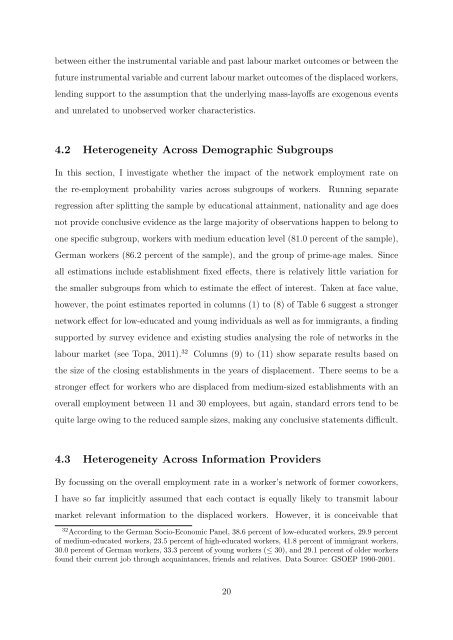paper - Universitat Pompeu Fabra
paper - Universitat Pompeu Fabra
paper - Universitat Pompeu Fabra
You also want an ePaper? Increase the reach of your titles
YUMPU automatically turns print PDFs into web optimized ePapers that Google loves.
etween either the instrumental variable and past labour market outcomes or between the<br />
future instrumental variable and current labour market outcomes of the displaced workers,<br />
lending support to the assumption that the underlying mass-layoffs are exogenous events<br />
and unrelated to unobserved worker characteristics.<br />
4.2 Heterogeneity Across Demographic Subgroups<br />
In this section, I investigate whether the impact of the network employment rate on<br />
the re-employment probability varies across subgroups of workers. Running separate<br />
regression after splitting the sample by educational attainment, nationality and age does<br />
not provide conclusive evidence as the large majority of observations happen to belong to<br />
one specific subgroup, workers with medium education level (81.0 percent of the sample),<br />
German workers (86.2 percent of the sample), and the group of prime-age males. Since<br />
all estimations include establishment fixed effects, there is relatively little variation for<br />
the smaller subgroups from which to estimate the effect of interest. Taken at face value,<br />
however, the point estimates reported in columns (1) to (8) of Table 6 suggest a stronger<br />
network effect for low-educated and young individuals as well as for immigrants, a finding<br />
supported by survey evidence and existing studies analysing the role of networks in the<br />
labour market (see Topa, 2011). 32 Columns (9) to (11) show separate results based on<br />
the size of the closing establishments in the years of displacement. There seems to be a<br />
stronger effect for workers who are displaced from medium-sized establishments with an<br />
overall employment between 11 and 30 employees, but again, standard errors tend to be<br />
quite large owing to the reduced sample sizes, making any conclusive statements difficult.<br />
4.3 Heterogeneity Across Information Providers<br />
By focussing on the overall employment rate in a worker’s network of former coworkers,<br />
I have so far implicitly assumed that each contact is equally likely to transmit labour<br />
market relevant information to the displaced workers. However, it is conceivable that<br />
32 According to the German Socio-Economic Panel, 38.6 percent of low-educated workers, 29.9 percent<br />
of medium-educated workers, 23.5 percent of high-educated workers, 41.8 percent of immigrant workers,<br />
30.0 percent of German workers, 33.3 percent of young workers (≤ 30), and 29.1 percent of older workers<br />
found their current job through acquaintances, friends and relatives. Data Source: GSOEP 1990-2001.<br />
20
















